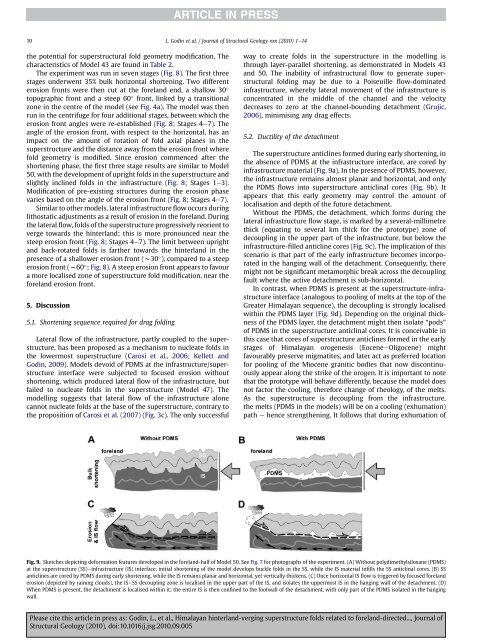Himalayan hinterland-verging superstructure folds related to ...
Himalayan hinterland-verging superstructure folds related to ...
Himalayan hinterland-verging superstructure folds related to ...
You also want an ePaper? Increase the reach of your titles
YUMPU automatically turns print PDFs into web optimized ePapers that Google loves.
10L. Godin et al. / Journal of Structural Geology xxx (2010) 1e14the potential for superstructural fold geometry modification. Thecharacteristics of Model 43 are found in Table 2.The experiment was run in seven stages (Fig. 8). The first threestages underwent 35% bulk horizontal shortening. Two differenterosion fronts were then cut at the foreland end, a shallow 30 <strong>to</strong>pographic front and a steep 60 front, linked by a transitionalzone in the centre of the model (see Fig. 4a). The model was thenrun in the centrifuge for four additional stages, between which theerosion front angles were re-established (Fig. 8; Stages 4e7). Theangle of the erosion front, with respect <strong>to</strong> the horizontal, has animpact on the amount of rotation of fold axial planes in the<strong>superstructure</strong> and the distance away from the erosion front wherefold geometry is modified. Since erosion commenced after theshortening phase, the first three stage results are similar <strong>to</strong> Model50, with the development of upright <strong>folds</strong> in the <strong>superstructure</strong> andslightly inclined <strong>folds</strong> in the infrastructure (Fig. 8; Stages 1e3).Modification of pre-existing structures during the erosion phasevaries based on the angle of the erosion front (Fig. 8; Stages 4e7).Similar <strong>to</strong> other models, lateral infrastructure flow occurs duringlithostatic adjustments as a result of erosion in the foreland. Duringthe lateral flow, <strong>folds</strong> of the <strong>superstructure</strong> progressively reorient <strong>to</strong>verge <strong>to</strong>wards the <strong>hinterland</strong>; this is more pronounced near thesteep erosion front (Fig. 8; Stages 4e7). The limit between uprightand back-rotated <strong>folds</strong> is farther <strong>to</strong>wards the <strong>hinterland</strong> in thepresence of a shallower erosion front (w30 ), compared <strong>to</strong> a steeperosion front (w60 ; Fig. 8). A steep erosion front appears <strong>to</strong> favoura more localised zone of <strong>superstructure</strong> fold modification, near theforeland erosion front.5. Discussion5.1. Shortening sequence required for drag foldingLateral flow of the infrastructure, partly coupled <strong>to</strong> the <strong>superstructure</strong>,has been proposed as a mechanism <strong>to</strong> nucleate <strong>folds</strong> inthe lowermost <strong>superstructure</strong> (Carosi et al., 2006; Kellett andGodin, 2009). Models devoid of PDMS at the infrastructure/<strong>superstructure</strong>interface were subjected <strong>to</strong> focused erosion withoutshortening, which produced lateral flow of the infrastructure, butfailed <strong>to</strong> nucleate <strong>folds</strong> in the <strong>superstructure</strong> (Model 47). Themodelling suggests that lateral flow of the infrastructure alonecannot nucleate <strong>folds</strong> at the base of the <strong>superstructure</strong>, contrary <strong>to</strong>the proposition of Carosi et al. (2007) (Fig. 3c). The only successfulway <strong>to</strong> create <strong>folds</strong> in the <strong>superstructure</strong> in the modelling isthrough layer-parallel shortening, as demonstrated in Models 43and 50. The inability of infrastructural flow <strong>to</strong> generate superstructuralfolding may be due <strong>to</strong> a Poiseuille flow-dominatedinfrastructure, whereby lateral movement of the infrastructure isconcentrated in the middle of the channel and the velocitydecreases <strong>to</strong> zero at the channel-bounding detachment (Grujic,2006), minimising any drag effects.5.2. Ductility of the detachmentThe <strong>superstructure</strong> anticlines formed during early shortening, inthe absence of PDMS at the infrastructure interface, are cored byinfrastructure material (Fig. 9a). In the presence of PDMS, however,the infrastructure remains almost planar and horizontal, and onlythe PDMS flows in<strong>to</strong> <strong>superstructure</strong> anticlinal cores (Fig. 9b). Itappears that this early geometry may control the amount oflocalisation and depth of the future detachment.Without the PDMS, the detachment, which forms during thelateral infrastructure flow stage, is marked by a several-millimetrethick (equating <strong>to</strong> several km thick for the pro<strong>to</strong>type) zone ofdecoupling in the upper part of the infrastructure, but below theinfrastructure-filled anticline cores (Fig. 9c). The implication of thisscenario is that part of the early infrastructure becomes incorporatedin the hanging wall of the detachment. Consequently, theremight not be significant metamorphic break across the decouplingfault where the active detachment is sub-horizontal.In contrast, when PDMS is present at the <strong>superstructure</strong>-infrastructureinterface (analogous <strong>to</strong> pooling of melts at the <strong>to</strong>p of theGreater <strong>Himalayan</strong> sequence), the decoupling is strongly localisedwithin the PDMS layer (Fig. 9d). Depending on the original thicknessof the PDMS layer, the detachment might then isolate “pods”of PDMS in the <strong>superstructure</strong> anticlinal cores. It is conceivable inthis case that cores of <strong>superstructure</strong> anticlines formed in the earlystages of <strong>Himalayan</strong> orogenesis (EoceneeOligocene) mightfavourably preserve migmatites, and later act as preferred locationfor pooling of the Miocene granitic bodies that now discontinuouslyappear along the strike of the orogen. It is important <strong>to</strong> notethat the pro<strong>to</strong>type will behave differently, because the model doesnot fac<strong>to</strong>r the cooling, therefore change of rheology, of the melts.As the <strong>superstructure</strong> is decoupling from the infrastructure,the melts (PDMS in the models) will be on a cooling (exhumation)path e hence strengthening. It follows that during exhumation ofFig. 9. Sketches depicting deformation features developed in the foreland-half of Model 50. See Fig. 7 for pho<strong>to</strong>graphs of the experiment. (A) Without polydimethylsiloxane (PDMS)at the <strong>superstructure</strong> (SS)einfrastructure (IS) interface, initial shortening of the model develops buckle <strong>folds</strong> in the SS, while the IS material infills the SS anticlinal cores. (B) SSanticlines are cored by PDMS during early shortening, while the IS remains planar and horizontal, yet vertically thickens. (C) Once horizontal IS flow is triggered by focused forelanderosion (depicted by raining clouds), the ISeSS decoupling zone is localised in the upper part of the IS, and isolates the uppermost IS in the hanging wall of the detachment. (D)When PDMS is present, the detachment is localised within it; the entire IS is then confined <strong>to</strong> the footwall of the detachment, with only part of the PDMS isolated in the hangingwall.Please cite this article in press as: Godin, L., et al., <strong>Himalayan</strong> <strong>hinterland</strong>-<strong>verging</strong> <strong>superstructure</strong> <strong>folds</strong> <strong>related</strong> <strong>to</strong> foreland-directed..., Journal ofStructural Geology (2010), doi:10.1016/j.jsg.2010.09.005
















